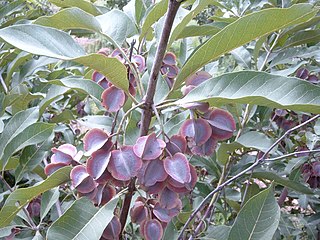
Combretum, the bushwillows or combretums, make up the type genus of the family Combretaceae. The genus comprises about 272 species of trees and shrubs, most of which are native to tropical and southern Africa, about 5 to Madagascar, but there are others that are native to tropical Asia, New Guinea and the Bismarck Archipelago, Australia, and tropical America. Though somewhat reminiscent of willows (Salix) in their habitus, they are not particularly close relatives of these.
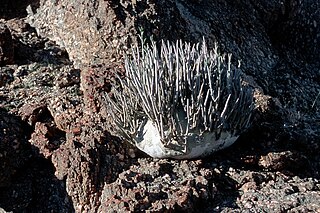
Adenia is a genus of flowering plants in the passionflower family Passifloraceae. It is distributed in the Old World tropics and subtropics. The centers of diversity are in Madagascar, eastern and western tropical Africa, and Southeast Asia. The genus name Adenia comes from "aden", reported as the Arabic name for the plant by Peter Forsskål, the author of the genus.
Athroisma is a genus of plants in the family Asteraceae first described as a genus in 1833. It is native to East Africa and Madagascar.

Badula is a small genus of 14–17 species of tropical shrubs, placed formerly in the plant family Myrsinaceae. The genus is largely endemic to Madagascar and the Mascarene Islands.

Secamone is a genus of plant in family Apocynaceae, first described as a genus in 1810. It is widespread across much of Africa, northern Australia, southern Asia, with numerous species endemic to Madagascar.
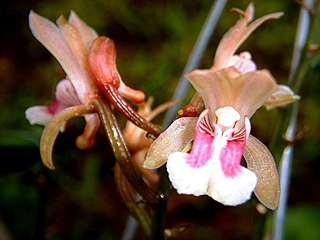
Oeceoclades, collectively known as the monk orchids, is a genus of flowering plants from the orchid family, Orchidaceae. It is related to Eulophia and like that genus is mostly terrestrial in habit. A few species extend into very arid environments, unusual for an orchid.

Cryptolepis is a plant genus in the family Apocynaceae. It includes some 42 species.

Cynanchum viminale is a leafless succulent plant in the family Apocynaceae. The species is native to West Africa, the Indian Ocean and Western Pacific region. The species' natural range extends from South Africa throughout much of Africa and the Middle East to India, Indochina, Southern China, Indomalaya and into Meganesia. The species is also found on several Indian Oceans islands including Mauritius, Réunion and the Seychelles.

Stapelianthus is a genus of flowering plants in the family Apocynaceae, first described as a genus in 1933. The entire genus is endemic to Madagascar and is concentrated in the far south of the island.
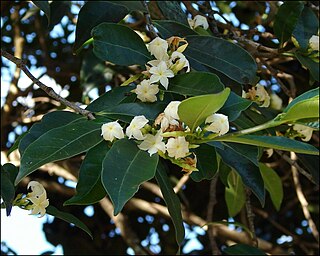
Mascarenhasia is a genus of plant in family Apocynaceae first described as a genus in 1844. It is native to Africa and a few islands in the Indian Ocean. Several species are endemic to Madagascar.
- Mascarenhasia arborescensA.DC. - Kenya, Tanzania, Zaire, Malawi, Mozambique, Zimbabwe, Comoros, Madagascar; naturalized in Seychelles
- Mascarenhasia havetiiA.DC. - Madagascar
- Mascarenhasia lanceolataA.DC. - Madagascar
- Mascarenhasia lisianthifloraA.DC. - Madagascar
- Mascarenhasia macrosiphonBaker - Madagascar
- Mascarenhasia rubraJum. & H.Perrier - Madagascar
- Mascarenhasia speciosaScott-Elliot - Madagascar
- Mascarenhasia tampinensisPichon - Madagascar

Tavaresia is a genus of plants in the family Apocynaceae, first described as a genus in 1902. It is native to southern Africa.
- Tavaresia angolensisWelw. - Angola
- Tavaresia barklyi(Dyer) N.E.Br. - South Africa
- Tavaresia grandifloraBerger - South Africa
- Tavaresia meintjesiiR.A. Dyer - Limpopo
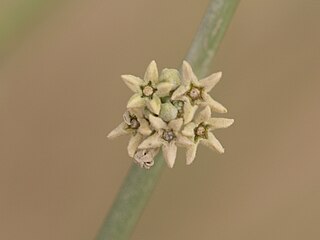
Leptadenia is a genus of plants in the family Apocynaceae, first described as a genus in 1810. It is native to Africa, including Madagascar, as well as southwest Asia and the Indian Subcontinent.
- Leptadenia arborea(Forssk.) Schweinf. - Sudan, Ethiopia
- Leptadenia lancifolia(Schumach. & Thonn.) Decne. - tropical Africa
- Leptadenia madagascariensisDecne. - Madagascar
- Leptadenia pyrotechnica(Forssk.) Decne. - widespread from Algeria to India
- Leptadenia reticulata(Retz.) Wight & Arn. - Madagascar
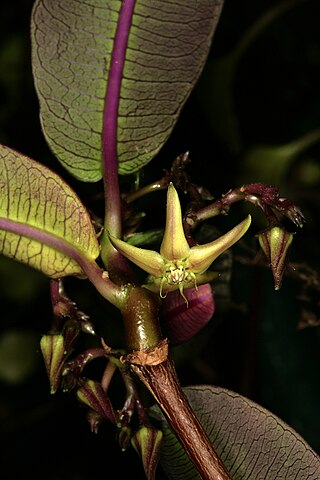
Ischnolepis natalensis is a climbing geophyte vine, commonly known as propeller vine, in the family Apocynaceae. It is native to Eastern Cape and KwaZulu-Natal provinces of South Africa.
Pentopetia is a plant genus in the family Apocynaceae, first described as a genus in 1844.

Ischnolepis graminifolia is a species of flowering plant in the dogbane family, Apocynaceae. It is a tuberous shrub endemic to Madagascar.

Tacazzea is a genus of plants in the family Apocynaceae, first described in 1890. It is native to Africa.

Raphionacme is a plant genus in the family Apocynaceae, first described as a genus in 1842. The genus is found primarily in Africa, with one species on the Arabian Peninsula.
Pervillaea is a genus of plants in the family Apocynaceae, first described as a genus in 1844. It is native to Mauritius and Madagascar in the Indian Ocean.
- Pervillaea brevirostrisKlack. - Mauritius
- Pervillaea decaryi(Choux) Klack. - Madagascar
- Pervillaea phillipsoniiKlack. - Madagascar
- Pervillaea tomentosaDecne. - Madagascar
- Pervillaea venenata(Baill.) Klack. - Madagascar
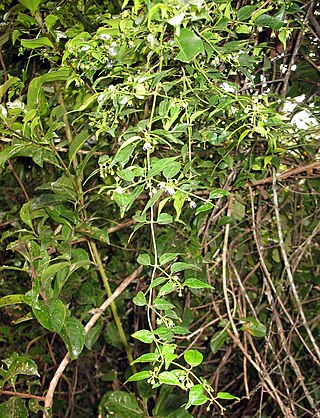
Camptocarpus acuminatus is a species of plant in the Apocynaceae family. It is endemic to the Madagascar. Pierre Choux, the botanist who first formally described the species, named it after the tapering tips of its leaves, using the synonymous name Tanulepis acuminata.















